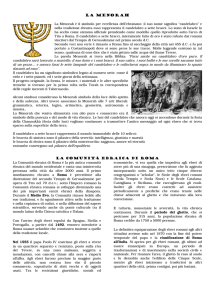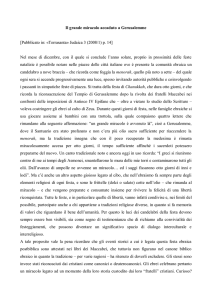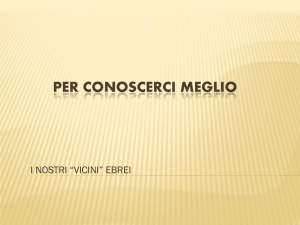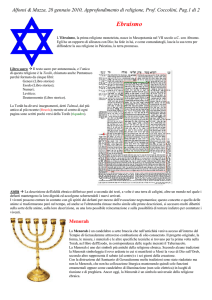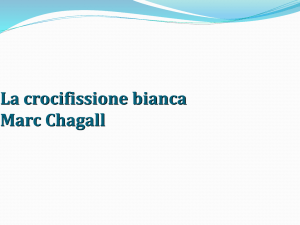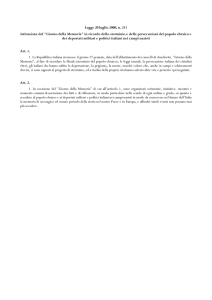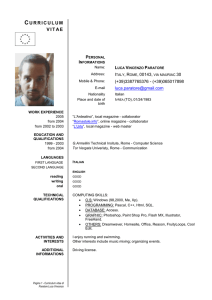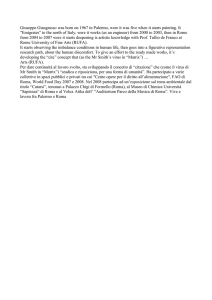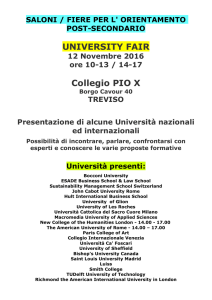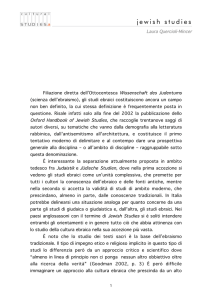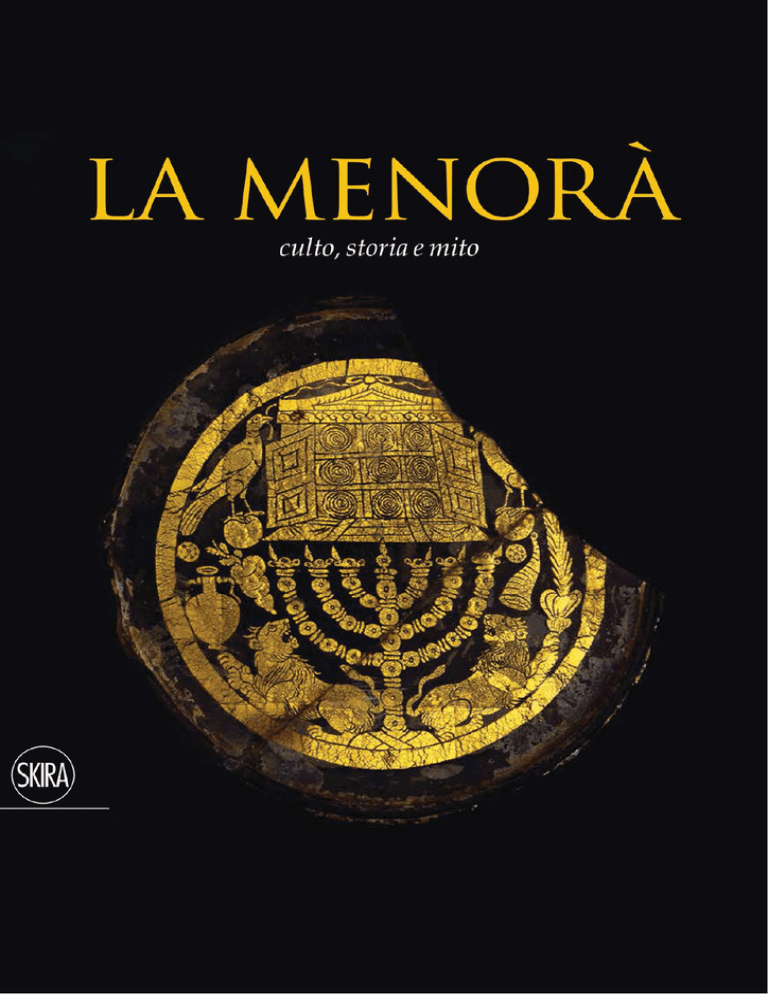
la menorà
culto, storia e mito
Mostra a cura di / Exhibition curated by
Alessandra Di Castro, Francesco Leone, Arnold Nesselrath
Catalogo a cura di / Catalog edited by
Francesco Leone
Alessandra Di Castro
Francesco Leone
Arnold Nesselrath
Le ragioni della mostra
I
l progetto sulla menorà nacque quasi quattro
anni fa. Allora pensammo che la realizzazione
di una grande mostra in perfetta cooperazione tra i Musei Vaticani e il Museo Ebraico di
Roma, fatto mai accaduto in precedenza, potesse essere da parte nostra – in qualità di storici dell’arte – un contributo concreto al dialogo e alla cooperazione tra due punti di vista distinti: quello ebraico
e quello cristiano. Pensammo anche che era con iniziative come quella che poi ha preso corpo intorno
alla mitica menorà che avremmo potuto contribuire,
per quanto competeva ai nostri ambiti professionali,
a rendere più solida e lineare la strada della reciproca
comprensione.
Il progetto che ne nacque riguardava il più antico
e importante simbolo identitario dell’ebraismo, dettagliatamente descritto nelle Sacre Scritture, di cui il
Signore mostrò addirittura a Mosè un’immagine sul
Sinai, e millenni dopo, a partire dall’epoca carolingia, ricalcato nelle sue forme dai candelabri a sette
bracci collocati nelle chiese cristiane a scopo liturgico.
L’idea fu partorita nell’ottobre del 2013, in occasione
di un incontro al Museo Ebraico di Roma con l’allora ambasciatore di Israele presso la Santa Sede Zion
Evrony, dinanzi a un’iscrizione conservata al Museo
in cui compare la menoràXQ´IDOVRµDQWLFRGLÀQH
Ottocento, che simula una lapide in cui si ricordano
tre fratelli uccisi sotto l’imperatore Onorio (morto nel
423 e.v.), che avrebbero visto la menorà sul fondale del
Tevere, non distante dall’Isola Tiberina, senza tuttavia
riuscire a recuperarla. Era il segno che a Roma, la città
fatale della menorà, il mito del candelabro era ancora
YLYRDOODÀQHGHO;,;VHFROR
Si decise allora di organizzare una mostra di ampio respiro su questo simbolo che avrebbe spaziato
da Oriente a Occidente, da Gerusalemme a Roma,
dal I secolo a.e.v. al XXI, partendo da una rassegna
SLFFRODPDVLJQLÀFDWLYDRUJDQL]]DWDQHOGDOO·DO-
lora direttrice del Museo Ebraico di Roma Daniela
Di Castro z.l., grande studiosa di arte ebraica (“Da
Gerusalemme a Roma, e ritorno: il viaggio della menorà fra storia e mito”). Un altro importante precedente era stato quello della mostra “In the Light of
the Menorah. Story of a Symbol” dell’Israel Museum
di Gerusalemme del 1998 per il cinquantenario dello
Stato di Israele.
Pensammo che Roma fosse il luogo ideale in cui
organizzare la mostra, perché a Roma la menorà giunse certamente nel 71 e.v. al seguito del generale Tito
dopo la distruzione del Tempio di Gerusalemme del
70, perché fu a Roma che della menorà si persero per
VHPSUHOHWUDFFHWUDODÀQHGHO,,HLO9VHFRORHSHUché, soprattutto, fu a Roma che tra il III e il IV secolo
la menorà da importante simbolo religioso ebraico
assunse la caratura universale di simbolo identitario
dell’ebraismo – religioso, culturale ma anche civile
– che ne ha addirittura fatto nel 1948 l’emblema del
neonato Stato di Israele.
Il progetto fu accolto con entusiasmo da Antonio
Paolucci, allora direttore dei Musei Vaticani, e con lo
stesso entusiasmo è stato promosso da Barbara Jatta, succedutagli da pochi mesi. La mostra, realizzata grazie alle generose contribuzioni di importanti
sponsor internazionali, tratta dunque dell’incredibile storia della menorà che ebbe inizio tremila anni fa:
il leggendario candelabro a sette bracci fatto forgiare in oro puro da Mosè, che illuminava con le sue
lampade l’area del Santo antistante il Santo dei Santi
prima nella tenda del convegno e poi nel Tempio di
Gerusalemme. Ne abbiamo raccontato il culto nel
mondo ebraico a partire dal primo Tempio, quello di
Salomone, la sua intricata storia reale e le leggende
che l’hanno interessata basandoci sulle fonti scritte
e sulle testimonianze visive che ci sono giunte. Tra
TXHVWHDGHVHPSLRLOJUDIÀWRLQFLVRVXOODPietra di
Magdala del I secolo a.e.v., quando il candelabro si
trovava ancora nel secondo Tempio a Gerusalemme;
il calco dell’arco di Tito, testimonianza autentica e
fedele dell’arrivo della menorà a Roma nel 71 e.v.; il
frammento della Forma Urbis Romae con la pianta del
Templum Pacis, dove la menorà fu custodita insieme
DJOLDOWULDUUHGLVDFULGHO7HPSLRDOPHQRÀQRDOOHÀQH
del II secolo. Abbiamo poi dato voce a tutte le suggestive leggende nate attorno alla misteriosa sorte del
candelabro, da quelle che la vogliono razziata dal re
dei visigoti Alarico nel 410 o dal re dei vandali Genserico nel 455. Fino alla leggenda che vuole la menorà
ancora conservata a Roma in epoca medievale, come
lascerebbe credere la cosiddetta Tabula Magna Lateranensis, una lunga iscrizione a tessere musive con letWHUHGRUDWHPXUDWDDIÀDQFRDOODSRUWDGHOODVDJUHVWLD
GL6DQ*LRYDQQLLQ/DWHUDQRULVDOHQWHDOSRQWLÀFDWR
di Niccolò IV (1288-1292) e di cui in mostra è esposta
una riproduzione, che annovera anche la menorà tra le
reliquie (troppe e incredibili) custodite nella basilica
lateranense e nella vicina cappella di San Lorenzo,
più nota come Sancta Sanctorum. Si tratta di racconti
fantasiosi, privi di fondamento, legati al fascino delle
reliquie provenienti dal Medioriente durante il lungo
periodo delle crociate. Ma sono bastate a perpetuare
ÀQRDWXWWRLO;;VHFRORODFUHGHQ]DFKHODmenorà potesse essere addirittura conservata segretamente in
Vaticano.
In epoca medievale la menorà godette di grande
fortuna tra i cristiani di tutta l’Europa. Chiese, santuari e duomi furono arricchiti di maestosi candelabri a
sette bracci, di cui gli esempi più impressionanti sono
l’enorme Candelabro Trivulzio nel duomo di Milano o
il candelabro nel Münster di Essen in Germania, naturalmente non trasportabili. Questa tradizione, che
riproduceva le forme della menorà, continuò per tutto
il Rinascimento e si è perpetuata sino a oggi, quando per esempio nel Münster sull’isola di Reichenau
vicino Costanza viene acceso un candelabro siffatto
durante la messa. La fortuna visiva della menorà continuò ancora potente nei secoli. Affreschi e dipinti da
Raffaello in avanti (La cacciata di Eliodoro dal Tempio
GHOOH6WDQ]H9DWLFDQHÀQRDO;,;VHFRORODULWUDJJRno ogni volta che si allude al Tempio di Gerusalemme. Mentre nel XX secolo, quando assurse anche a
protagonista di capolavori della letteratura mondiale
come Il candelabro sepolto di Stefan Zweig (1937), molti
artisti ebrei sfuggiti ai pogrom degli inizi del secolo e
alle persecuzioni imposte alle comunità ebraiche dei
loro rispettivi luoghi d’origine ne fecero nei contesti
di approdo un manifesto tangibile e molto diffuso di
identità culturale e religiosa.
La nostra sfida, consegnata a uno strumento
di dialogo universale come soltanto l’arte (e la sua
storia) può essere, è stata quella di tradurre questo
UDFFRQWRÀORORJLFRHVWRULFDPHQWHIRQGDWRLQXQD
esperienza emblematica per il visitatore. Per questa
ragione la mostra è organizzata in due sedi complementari: il Tempio Maggiore di Roma, dove ha sede il
Museo Ebraico, e piazza San Pietro. Il biglietto unico
per accedere ai due luoghi, gestiti dalle due istituzioni distinte, è inteso come simbolo, come un’unica
chiave per accedere ai due musei e a due mondi diversi ma complementari e a pochi passi di distanza
l’uno dall’altro.
Quando, nel corso della storia (e purtroppo il
mondo di oggi non ne è esente), le opere d’arte sono
state trafugate come bottini di guerra, la scelta è stata sempre dettata da mire materialistiche e da manie
di appropriazione. A dispetto dei danni giganteschi
causati da queste drammatiche spoliazioni, il valore
etico connaturato alle opere d’arte trafugate ne ha
trasformato in alcuni casi, paradossalmente, la ricezione negli ambienti di arrivo in poderosi strumenti
di civiltà e di confronto. Nel caso della menorà questo
potere si perpetua ancora oggi, a quasi due millenni
GDOODVXDGHÀQLWLYDVFRPSDUVDD5RPD
Alessandra Di Castro
Francesco Leone
Arnold Nesselrath
The Reason for the Exhibition
T
he menorah project was born nearly four
years ago. We thought that a major exhibition jointly produced by the Musei Vaticani and the Museo Ebraico in
Rome—something that had never happened before—would enable us, as art historians, to
make an actual contribution to dialogue and cooperation between the Jewish and the Christian world,
each with its own perspective. We also thought that
it was through initiatives like this one, constructed
around the legendary menorah, that we would be able
to contribute, in our professional capacity, to giving
the road to mutual understanding a more solid foundation and making it more direct.
The project is based on the most ancient and
important identity symbol of Judaism. The Bible
states that God actually showed Moses an image of
the menorah on Mount Sinai, and thousands of years
later, starting in the Carolingian period, its form was
reprised in the seven-armed candelabra placed in
Christian churches for liturgical purposes. The idea
for the exhibition sprang from a meeting with the then
Israeli Ambassador to the Holy See, Zion Evrony, at
the Jewish Museum in Rome in October 2013. It was
triggered by an inscription conserved in the Museum, accompanied by an image of a menorah: a “fake”
antique from the late nineteenth century, a copy of
a gravestone in memory of three brothers who were
killed during the reign of the Emperor Honorius (died
423 CE)—who saw the menorah on the bottom of the
river, not far from the Tiber Island, but did not succeed in recovering it. It was a sign that the legend of
the candelabrum was still alive in the city that proved
fateful to it, at the end of the nineteenth century.
It was then decided to organize a major exhibition on this symbol, ranging from East to West, from
-HUXVDOHPWR5RPHIURPWKHÀUVWFHQWXU\%&(WRWKH
WZHQW\ÀUVWFHQWXU\,WZRXOGEHEDVHGRQDVPDOOEXW
important show (Da Gerusalemme a Roma, e ritorno: il
viaggio della menorà fra storia e mito) organized in 2008
by the then Director of the Jewish Museum in Rome,
Daniela Di Castro Z”L, a leading expert on Jewish art.
This was preceded by another seminal exhibition, In
the Light of the Menorah. Story of a Symbol, at the Israel
Museum in Jerusalem in 1998, held to celebrate the
50th anniversary of the founding of the State of Israel.
We believed that Rome was the ideal place to
host the show, because we know for certain that the
menorah was brought to Rome by General Titus in 71
CE, following the destruction of the Temple of Jerusalem in 70 CE. It was also in Rome that all trace of the
menorah was lost between the end of the second and
WKHÀIWKFHQWXU\DQGDERYHDOOLWZDVLQWKLVFLW\WKDW
between the third and fourth century, this important
icon of the Jewish religion became a universal identity symbol of Judaism—religious, cultural, and also
civil. So much so, that it was adopted as the emblem
of the newly founded State of Israel in 1948.
The project was enthusiastically received by Antonio Paolucci, then Director of the Musei Vaticani,
and was promoted with the same enthusiasm by Barbara Jatta, who took over from him a few months ago.
The exhibition, produced with the help of
generous contributions from leading international
sponsors, tells the extraordinary story of the menorah, which began 3000 years ago. The legendary
seven-armed candelabrum was forged by Moses in
pure gold, and its lamps illuminated the Holy Place
in front of the Holy of Holies, first located in the
tabernacle of the congregation and then in the Temple of Jerusalem. The show recounts worship in the
Jewish world from the time of the First Temple, built
by Solomon, the menorah’s complex history and the
legends that have surrounded it, on the basis of written sources and visual testimonies that have come
GRZQWRXV7KHVHLQFOXGHWKHJUDIÀWRLQFLVHGRQWKH
Magdala stoneIURPWKHÀUVWFHQWXU\%&(ZKHQWKH
candelabrum was still in the Second Temple in Jerusalem; the cast taken from the Arch of Titus, an
authentic and accurate testimony of the arrival of the
menorah in Rome in 71 CE and the fragment of the
Forma Urbis Romae with the plan of the Templum Pacis, where the menorah was kept along with the other
sacred furnishings of the Temple at least until the end
of the second century. The exhibition also explores all
the fascinating legends that have sprung up around
the mysterious fate of the candelabrum, such as its
being looted by Alaric, King of the Visigoths, in 410
or by Genseric, King of the Vandals, in 455. Another tale has it that the menorah was still in Rome in
medieval times, as indicated by the so-called Tabula
Magna Lateranensis, a long mosaic inscription with
gilded letters attached to the wall near the door of the
Sacristy of St. John Lateran, which dates to the papacy of Nicholas IV (1288–1292). A reproduction of the
tabula is on display in the exhibition. It mentions the
menorah among the incredible number of reliquaries
in the Lateran Basilica and the nearby chapel of San
Lorenzo, better known as the Sancta Sanctorum. All
these legends are fanciful tales, completely unfounded, generated by the fascination held by the reliquaries brought from the Middle East during the long
SHULRGRIWKH&UXVDGHV1RQHWKHOHVVWKH\VXIÀFHGWR
perpetuate, until the end of the twentieth century,
the belief that the menorah was secretly preserved in
the Vatican.
In the Middle Ages, the menorah was extremely
popular in Christian Europe. Churches, sanctuaries,
and cathedrals were enriched with majestic seven-armed candelabra, two of the most striking being
the enormous Trivulzio Candelabrum in Milan Cathedral and the one in the Essen Minster in Germany,
which, of course, cannot be transported. This tradition of reproducing the forms of the menorah contin-
ued throughout the Renaissance and, indeed, is still
upheld; in fact, in the minster on Reichenau Island
in Lake Constance a candelabrum of this type is lit
during Mass. The popularity of the menorah continued
undiminished through the centuries. It is depicted in
frescoes and paintings from Raphael (7KH([SXOVLRQ
of Heliodorus from the Temple in the Vatican Rooms) to
the nineteenth century, every time the Temple of Jerusalem is alluded to. While in the twentieth century,
when it also became the protagonist of international
literary masterworks like The Buried Candelabrum by
Stefan Zweig (1937), many Jewish artists who had
escaped the pogroms at the beginning of the century and the persecutions of the Jewish communities
in their homelands, made it a tangible, widespread
“manifesto” of their cultural and religious identity in
the places where they settled.
Art and its history are an extraordinary means
of universal dialogue, which we used to translate
the menorah’s philological and historically grounded story, into a symbolic experience for the visitor.
That is why the exhibition is organized in two complementary venues: the Great Synagogue in Rome,
which is home to the Museo Ebraico, and St. Peter’s.
The single ticket providing entrance to both venues,
managed by two different institutions, is seen as symbolic: one key to enter two museums and two diverse
yet complementary worlds, just a stone’s throw away
from each other.
In the course of history—and unfortunately still
today—works of art were appropriated as war booty.
Despite the devastating damage caused by such tragic
lootings, the innate moral value of these stolen works
of art, paradoxically, in some cases transformed them
into powerful statements of culture and dialogue in
their new homes. This is true of the menorah, whose
symbolic value is still as strong, almost 2000 years
DIWHULWVGHÀQLWLYHGLVDSSHDUDQFHIURP5RPH

